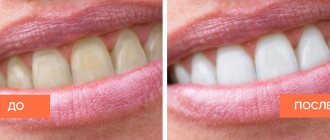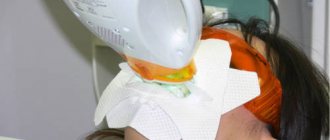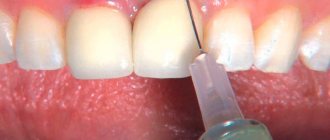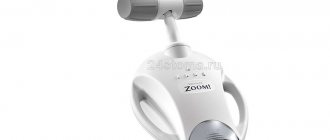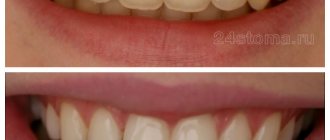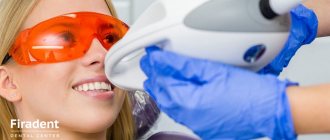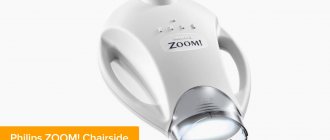Although whitening is a cosmetic procedure, it must be approached with the utmost seriousness, otherwise you risk, at best, not getting results, and at worst, ruining the health of your teeth.
Therefore, if you have dreamed of a snow-white smile all your life, do not rush. First, go through the entire range of preparatory procedures to be sure of the health of your oral cavity.
We'll tell you what you need to do before teeth whitening, what pitfalls and contraindications there may be.
Types of professional teeth whitening
Reviews about types of teeth whitening on the Internet make many patients believe in the myth about the effectiveness of hydrogen peroxide purchased at the pharmacy, soda, activated carbon and other simple methods. Following such dubious advice is not only pointless, but also fraught with dangerous consequences - burns of the oral cavity, damage to the enamel and increased sensitivity of the teeth. In fact, there are only two types of professional whitening – in-office and at-home.
How to behave after the whitening procedure?
- What recommendations should you follow?
- Soreness after a session: what does it mean?
- Dietary advice: what is prohibited?
- What is better to forget: bad habits
After a procedure that improves the shade of the dental surface, each of us has a rational question: “What to do after teeth whitening and what is it better to refrain from so that the effect lasts as long as possible?”
At first, after exposure, teeth become especially sensitive to various negative factors; they require high-quality and constant care. There is a list of rules that must be followed. It is their conscientious implementation that ensures that the dental rows remain white for many months.
In-office bleaching
This term in dentistry means teeth whitening under the supervision of a doctor using gels based on hydrogen peroxide or urea, as well as catalysts in the form of ultraviolet light or a laser beam. The chemical composition affects only 20% of the organic substances contained in hard dental tissue (dentine) and does not cause any harm to the teeth. The final result of the procedure depends on the initial shade of the teeth, determined according to the VITA scale. In most cases, it is possible to achieve a lightening of 5 to 10 tones. Let's look at the features of each type of teeth whitening in the clinic.
Photobleaching
During photo-whitening, the whitening gel is applied to the tooth surface from the front. The action of the product is accelerated by a lamp with ultraviolet radiation. One session lasts 15 – 30 minutes. The maximum change in tooth shade is possible by 8 – 10 tones. The cost of the service is about 10,000 rubles.
Laser whitening
The reagent on the teeth is catalyzed by a laser beam rather than an ultraviolet lamp. Each tooth is processed separately. In one laser whitening procedure, you can improve your color by 12 shades. The price of an effective technique is proportionally high - from 20,000 rubles per session.
Chemical bleaching
In chemical whitening, a whitening gel is applied to the surface of the teeth, and no ultraviolet light or laser is used. The method is gentle, so teeth become whiter by only 5 to 7 tones. The cost of the procedure is about 12,000 rubles.
In-canal whitening
It is used when the tooth has darkened due to filling the canals with coloring materials. The dentist drills a hole in the tooth cavity, applies a brightening agent and places a temporary filling. After achieving the desired result, the final restoration of the tooth is carried out. Endo-whitening costs approximately 1,000 rubles per tooth.
Contrary to what many patients believe, the popular Air Flow procedure involves mechanical cleaning and not teeth whitening. A powerful stream of air, water, soda and other components removes bacterial and hard plaque, polishing and leveling the tooth surface. After the session, the teeth visually become whiter because they have been cleaned of impurities and returned to their natural color. The same can be said about ultrasonic whitening.
Causes of darkening of enamel
The main factors that influence the shade of teeth:
- regular consumption of coffee, strong black tea, foods with dyes;
- bad habits, especially smoking;
- metabolic disorders in the body, systemic diseases;
- long-term use of certain groups of medications (in particular, drugs with tetracycline, etc.);
- reaction to a filling;
- natural age-related changes;
- depulpation (nerve removal).
Home whitening
The method is suitable for those who want to whiten their teeth without risk to health and save a lot of money. However, before using whitening at home, it is recommended to consult a dentist to avoid mistakes when choosing the appropriate product and in the process of using it.
Home whitening systems with trays
Gel with individual trays for home whitening is issued in dentists after consultation with a doctor. Simpler sets with standard mouth guards can be purchased at the pharmacy. Due to the low concentration of hydrogen peroxide or urea in the gel, teeth are lightened by 5 to 8 tones. The price of the set varies from 2,000 to 7,000 rubles. The cost of making an individual mouthguard will be about 6,000 rubles.
Stripes
The devices contain a gel with a small content of hydrogen peroxide. The strips are applied to the teeth for about 30 minutes for a month. The effect is lightening by 3 – 5 tones. The cost of the kit is from 1,000 to 4,000 rubles. Perhaps the most effective means of this type will be Crest strips.
Gels and varnishes
The teeth are coated with a whitening agent with remineralizing components using a brush or brush. As a rule, the solution does not require rinsing and is used regularly for two weeks. Teeth become 1–2 shades whiter. Purchase costs will range from 300 to 1,000 rubles. One example of such products is the Blanx whitening pencil.
Whitening pastes
Toothpastes, rinses, brushes and flosses with a whitening effect in rare cases “increase” whiteness by a maximum of 1 tone. Experts recommend using such products to maintain the results of professional whitening. The simplest whitening paste can be bought at an affordable price - from 150 rubles. Low-abrasion toothpaste with a brightening effect, Extreme Whitening Swissdent, will cost more.
Hygienic care rules
Since the gums and dental tissues become more sensitive and weakened during the first few weeks, special hygiene requirements must be observed:
- Replacing the brush. Bacteria accumulate on the bristles over time, so it is recommended to change the dental plaque removal tool once every three months. After the whitening procedure, this must be done immediately, as the gums and enamel may be slightly injured. Even small cracks will become a path for pathogens to penetrate inside. You need to buy a brush with soft bristles, and after a few weeks replace it with a harder one.
- Competent selection of toothpaste. Products are chosen with low abrasiveness. This indicator indicates the strength of plaque abrasion, or, more simply, hardness. In the specifications it is indicated by the abbreviation RDA. It should be within 30 - 50 units. To strengthen the surface layer and saturate the enamel with microelements, pastes with fluoride or calcium are chosen. The higher the percentage of these substances, the better. If gum sensitivity is increased, then buy restorative gels with herbal extracts.
- Mouth rinses. After eating, be sure to rinse your mouth with clean water or mouthwash. If there is inflammation of the gums, use safe antiseptic solutions: Chlorhexidine, Miramestin, Rotokan. Do not rinse with herbal decoctions, as they can stain.
- Comprehensive care. To maintain hygiene at a high level, additional devices are used: interdental brushes, flosses, irrigators. If teeth have been additionally cleaned to remove supragingival or subgingival calculus, anti-inflammatory and regenerating drugs are applied to the gums, for example, Metragil Denta.
In order to always have white and healthy teeth, you need to undergo professional oral hygiene at the dentist once every six months.
Pros and cons of types of teeth whitening
Photobleaching
- Instant results.
- Uniform impact.
- The duration of the session is no more than an hour.
- Whitening by 8 – 10 tones.
- The occurrence of tooth sensitivity during and after the procedure.
Laser whitening
- Instant results.
- No discomfort during the procedure.
- Maintaining the acid balance of the oral cavity.
- Strengthening enamel.
- Whitening by 12 tones.
- The duration of the session is more than an hour.
- Uneven teeth whitening.
- High price.
Chemical bleaching
- Instant results.
- Uniform impact.
- Acceptable price.
- Simplicity of the procedure.
- Whitening by 5 – 7 tones.
- The occurrence of tooth sensitivity during and after the procedure.
- The need for several sessions.
In-canal whitening
- Local effect on tissue.
- Painless.
- Whitening by 5 – 7 tones.
- Weakening of dental tissues.
- Prohibition on repeating the procedure.
Whitening on trays
- Affordable price.
- Possibility to use the mouth guard at any time.
- Whitening by 5 – 8 tones.
- The duration of the course is 1 month.
Lightening strips
- Visible effect after the third application.
- Affordable price.
- Whitening by 3 – 5 tones.
- Inconvenient to use.
- The duration of the course is 1 month.
Varnish or pencil
- Ease of use.
- Minimum costs.
- Lightening by 1 - 2 tones.
- Poor efficiency.
Contraindications
Even if the patient has figured out what is the most effective and best method of teeth whitening, it is necessary to make sure that there are no restrictions. The procedure is contraindicated in:
- gestation and lactation period;
- the patient’s minor age, primary occlusion;
- individual intolerance to the components of whitening products;
- presence of orthodontic structures;
- oncological processes and undergoing a course of chemotherapy;
- damage to hard and soft tissues due to traumatic or other impacts;
- installed artificial prostheses;
- chronic pathologies of teeth and gums in the acute stage, acute dental diseases.
Each case is considered by the dentist individually. If you whiten your teeth if there are absolute restrictions, this can lead to serious complications.
Indications and contraindications for ZOOM 4 whitening
Whitening ZOOM 4
This procedure is usually used for the same reasons as other whitening procedures:
- dissatisfaction with the natural shade in the smile area;
- smoker's pigmented coating is a consequence of many years of addiction;
- restoration of uniform color of teeth after braces.
Contraindications to this procedure are also traditional:
- age up to 16 years;
- oncological diseases;
- inflammation of the oral cavity in the acute stage;
- untreated caries;
- regular use of antibiotics and oral contraceptives;
- epilepsy and other neurological disorders;
- allergy to the components of the whitening gel.
Do not forget that ZOOM 4 whitening is a purely cosmetic procedure. Before signing up for a session, you must undergo an examination by a dentist, cure all diseases of the teeth and gums, so as not to provoke complications.

